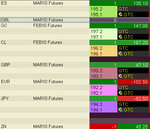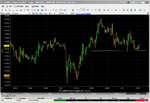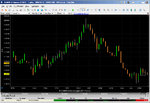More thinking on my micro-trading.

In a downtrend, you'd only be using one third of the moves. Because the breakout part is not being used. The retesting upward move is not being used (since it'd be against the trend). You're only using the part where it goes from the previous support that now has become resistance to the new support. So that's 33% of the move. The same happens for the upward trend.
Trend which, rather than being filtered, should be identified as higher highs and higher lows (with legs about 10 ticks long) and viceversa for the downtrend. No need for using the hourly candles, so we avoid using an extra chart.
In a range, at the bottom of the downtrend (for example), we're expecting (for example) most likely a rise at this point, so we will only play the 50% part of the move that goes up.
Importantly, the last leg down of the downtrend is - we don't know it when we trade it - the first leg down of the range to come. This shows how not playing the breakout prevents us from losing in all situations in which a trend turns into a range, which is quite often.
Now it all comes down to seeing if I can apply this at an hourly level on an intraday chart, because if I can do this on a different timeframe, then I am all done.
Today they fooled me and took 3000 from me, but usually support and resistance work well, especially because they don't pull these stunts on every intraday level, but maybe only once a month on the major ones, levels that lasted for weeks.
[...]
It works. The same thing, more or less, happens on an hourly level and so on. As seiden said, s/r works on all timeframes.
So this means for my "diversified" system that I'll do as follows.
1) set up the hourly candles
2) during the day, only trade the 33% moves described at length for the 1 minute GBP candles
3) during the night, trade any tipe of reversal (in any direction) because at night that's what you get: reversals. On the other hand, if you get a reversal at night and during the day you have trend continuation (as my stats show), then I should place the stoploss accordingly (for a short trade, slightly above the previous high).
Believe it or not, after losing for 12 years, I had never really given support/resistance a chance: simply because everyone was talking about it, I assumed it was crap. Just like everyone talks about paris hilton. I've gotten used to thinking that if everyone talks about something it's crap. And so I had excluded the three things that work the most: trend, s/r, stoploss. I wasn't using any one of them.







